This piece is titled Virahanka’s Bouquet has been in the making since #SoftLads was first conceived! When I decided on the first few images I wanted to create as larger final pieces I was immediately drawn to the image on @jakealawson Instagram. His sacred geometric tattoos are incredible and there is an interesting sense of balance and symmetry he has created with his tattoos on his chest.
When I first began the project, I drew out three large imag
es using a projector based on guys with tattoos on Instagram with captivating images. Hardcore Vibes was based on @alex_hace and Pilgrim based on @ezcolinatrader were the other two images I had initially sketched out alongside the image of @jakealawson.
Once I had drawn all three, I quickly realised I needed to build up my skills before I tried to create @jakealwason’s image because his tattoos are so intricate. I then put his initial drawing to the back burner which I ultimately think was the right decision because creating his image has been the most challenging to create out of all my images!
I also needed time to really think through what it was I was trying to articulate with his image in comparison to the rest of the individual themes of the series. I always knew I wanted to initially respond to how his tattoos connected to Eastern Culture when he is Londoner who is white and explore how Instagram creates a growing sense of globalised identity and community.
I am interested in the cultural politics at play when it comes to identity. I love that @jakealawson’s tattoos draw from these mathematical concepts. Maths is often described as a universal language, when googling why we have this term, google provided this neat answer-
‘Because mathematics is the same all over the world, math can act as a universal language. A phrase or formula has the same meaning, regardless of another language that accompanies it. In this way, math helps people learn and communicate, even if other communication barriers exist.‘
I also recognised his designs having a culturally Eastern influence. I recognised the patterns in Mandalas which are rooted in ancient Buddism. Mandalas were produced in Tibet, India, Nepal, China, Japan, Bhutan, and Indonesia and date from the 4th century to present.
Floral Mandalas often are associated with representations of femininity and the blossoming of life.
They can also represent a range of meanings from creation to growth and rebirth and other associations with cyclical patterns of life. There are two floral mandala’s patterns on @jakealwson’s chest, with a lotus between them approaching his throat. (I love that he had a lotus flower closer to his throat, like he has discovered his voice or truth.) Below this is a larger floral mandala triangulating between the other two toward his sternum. In the centre of these floral designs is the bases of a sacred design- the seed of life. The surrounding petals bloom outwardly from this point and become the flower of life. The petals have been artistically embellished from the geometric design but are all rooted in these mathematical constructs.
For a bit of further information on the foundations of sacred geometry, this link provides a helpful introduction with examples of the seed of life and how it evolves to become a flower of life and then a tree of life!
I love that this equation can be observed in nature and is reflected in lots of naturally occurring things. I like that it results in a growing spiral, the idea that it is a construct which is constantly growing and changing naturally. I love that this phenomenon is both observed in nature and through maths. That there is this universal pattern which is influencing everything.
The origins of sacred geometry trace back further in history. Its origins are traced back to the 2000 BCE–1001 BCE in Egyptian and Mesopotamian cultures. Thirteen centuries later, when various philosophers and thinkers –amongst them the brilliant Pythagoras– started seriously studying its potentials, it blossomed in ancient Greece. A more detailed introduction can be found here.
I am interested in this idea of universal language and communication as well as this notion of ownership of language and culture which is a part of what I am exploring in this piece. It amazes me how many tattoo designs incorporate sacred geometry. This growing, repeating pattern that exists in tattoos on people across the globe. It is all rooted in a sense of creation and has a connection through time to our earliest civilisations. There is a universal understanding in its value and something that connects us all.
The reason why the piece is called Virahanka’s Bouquet is because I want to honour Virahanka who is less well known than Leonardo Fibonacci who created what is known as the Fobonacci sequence or is also known as the Golden Ratio. The two terms are slightly different to each other but connect back to the same principle which is detailed further in this explanation here:
(If you believe that math's is a ‘universal language’ but after reading the article in full you might question how accessible the language of math's really is!) What I am more interested in is how Virahanka has been rediscovered and how Fibonacci had a dominant association with this equation.
As a short explanation:
‘The first to lay the groundwork was Pingla (c. 200 BC). Later, Virahanka (c. 700 AD) expanded upon his work and drafted the Fibonacci Sequence that we all know today. However, Virahanka's writings are now lost. He is believed to be the first one to create the Fibonacci Sequence due to a reference in a journal written around 1135 by the scholar, Gopala.’
Scourced:
Virahanka observations along with Pingla were observed from poetry. The implications of their equations can be observed in drumming, visual arts, architecture and is often seen in nature. To take this idea figuratively; if Pingla was the seed of life, then Virahanka is the flower of life; taking an initial idea and letting it blossom into a full equation.
In my piece I wanted to honour Virahanka’s ideas and highlight the relationship between history and communication. I also wanted to connect these ideas with this idea of blossoming or evolving. I have two figures in this piece, I wanted to have one figure as a representation of where we are currently and a second figure who is representing what we are growing into. The second figure is also a reflected mirror image of @jakealawson showing a spiritual aspirational version of the ‘self’. I am questioning who we all are and what do we want to become as we evolve. I am asking the question what will evolve into next? How will technology shape this change and who will we become.
I made further reference to this idea of evolution by including an image of an abstracted image referencing the tree of life. The tree of life or universal tree of life is a metaphor, model and research tool used to explore the evolution of life and describe a connection between organisms, both living and extinct. This was originally described in a popular passage in Charles Darwin's On the Origin of Species (1859). The idea of evolution connects through to my other portrait “Adaptive Evolution’ which you can read a full reflection on here:
I have a couple of links here which show tattoos of people interpretation of the tree of life and a wiki page about it here:
Tattoos and visualisations of the tree of life:
More information about the tree of life can be found here:
I wanted something to reflect our biological evolution and have an image which was connected to the spiral shape growing outwardly. I wanted to nod the relationship between nature and how we visually communicate.
In the piece above my interpretation of the tree of life are some hieroglyphs to reference an example of early writing, an ancient visual language. Using hieroglyph also help make a connection back to the roots of sacred geometry being born from the Egyptians. This moves on an image of a wild boar which is taken from one of the earliest examples of cave paintings.
I am exploring the idea of communication and evolution further and more in-depth in my piece “Hardcore Vibes. The piece draws on more examples of old forms of communication through tribal tattoos to new forms of communication such as emoji’s on instagram comments. You can read the full reflection here:
Further down in the piece is an emoji to highlight how our visual language still exists and is evolving with us. I have also included two hashtags #apex and #Alpha with a fire emoji which could translate to things like #Alphafire or #Alphahotty. These were added to connect the image of @jakealawson’s instagram account. I am questioning what the biological, evolutionary purpose of Instagram is. Is it a form of tribal competition whereby we compete to achieve more likes and comments to demonstrate our value and attractiveness amongst our peers? I don’t believe Instagram serves a single purpose, but I do think there is an innate biological reaction occurring to compete. The platform provides an evolutionary purpose to demonstrate our ‘personal assets’ to a global audience. Likes and comments are a form of social validation amongst our peers to demonstrate this person is someone to admire and considered valuable.
DETAIL PHOTOGRAPH IS COPYRIGHT OF HAND & LOCK PRIZE FOR EMBROIDERY
I like that we can now create subcultures of mutual interest through hashtags to cut through the voice and identify the subject that is of interest. All the models referenced in this series were found through either #facialtattoos, #Tattoos, #bodytattoos. I like that we have created this shorthand language to make these connections.
I have also included an image of binary language which is hidden across the secondary figure. The binary translates to “We Contain Multitudes’
We Contain Multitudes is the title of Sarah Henstra’s young adult novel. I wanted to include this title as it partly influenced the piece when I read the book and consequently ‘Leaves of Grass’ which is by Walt Whitman, which is what the title of Henstra’s book is based upon.
In the book We Contain Multitudes the story focuses on two characters; Jonathan Hopkirk and Adam "Kurl" Kurlansky who are partnered in English class. They are set a task to write letters to one another in a weekly pen pal assignment. Jonathan is obsessed with Walt Whitman and the Leaves of Grass and across the whole story there is a regular reference to the poems. This led to me picking up my dusty copy, which I’ve never read and tried to reread. I honestly gave up quickly because I have a version which is a slim paperback, and the writing is tiny. So, I went to my trusted Audible and downloaded a copy and listened to the book instead. It’s much more accessible, especially as the recording is over 18 hours long!
I now have heaps of notes throughout the recording; I really love the text and it absolutely resonates with lots of the themes I am trying to explore in this piece. The poem goes from exploring the self, community, love and existence. The poems connect to politics, history, spirituality and religion, concepts of the soul and sexuality and everything layered in meaning and curiosity and excitement for life.
There is a line in the poem which read ‘I contain multitudes’ instead of ‘we’ which was used in the title of Henstra’s book. Walt Whitman's full poem is written here:
Song of Myself, 51
I concentrate toward them that are nigh, I wait on the door-slab.
I wanted however to use Henstra’s title ‘We Contain multitudes’ because I liked how it was a progression, from the original seed of Walt Whitman’s idea in his poem that had then flowered into the novel We Contain Multitudes (which was now being reinterpreted by me in this piece).
This title also reflects the notion that we are made up of lots of things and some of those things contradict or are at odds with each other. The idea that these multitudes of different things build up to a greater picture, a sum of many parts.
(The binary coded in the piece translates to 'We Contain Multitudes')
I used binary as a ‘coded’ way of presenting this statement as I also wanted to show another type of language which is hidden within the piece.
I have previously referred to poetry within my work as I did with the piece Pilgrim, where I added a line from On Earth We Are Briefly Gorgeous; a debut novel by Vietnamese-American poet Ocean Vuong. You can read further about this here:
I wanted to incorporate poetry as it connected back to Virahanka's ideas. The equation he was describing was initially drawn from beats in poetry and drumming. I like how these ideas connect to a larger structure like beats or rhythms within life, this overarching connection that vibrates through us all.
This idea follows through the rest of the image. In the foreground of the second spiritual figure, is a spiral that follows the golden ration, showing the ratio of facial and body proportions and continues to grow outwardly.
In the background of the spiral and the figure is a continuation of the flow of the spiral's curve. In this curve I’ve made several different references. The Curvature looks a little like a spliced plant stem. The cells uniformly clustered together to form a circular structure.
Then embedded in this design I have incorporated fabrics with stars in the print to reflect the notion of how spirals can be observed in everything from cells to galaxies. I want to provide this sense of connection in every living thing.
In the piece the spiraling curve also has other references. Amongst the stars are also textiles patterns with stags which continue from the where the wild boar is positioned on the image. I wanted this to feel like other images found on cave paintings with images of herds painted on cave walls.
Either side of the figures is another reference to Whitman’s the Leaves of Grass. His cluster of poems Calamus arguably are the most notable poems of gay expression which he describes as "the manly love of comrades". When you read these poem’s, they reflect tender notions of homoerotic male love. The poems devote themselves exclusively to celebrating the “hidden life” of “manly attachment” and revealing its importance and beauty. Calamus is a reed plant that grows in wetlands Whitman says in the fourth part of the poem:
I wanted to include these reeds in the piece as I learnt that some think that Calamus is related to the legend Kalamos:
‘Kalamos and Karpos, the son of Zephyrus and Chloris. Karpos drowned in the Meander river while the two were competing in a swimming contest. In his grief, Kalamos allowed himself to drown also. He was then transformed into a water reed, whose rustling in the wind was interpreted as a sigh of lamentation’
The intention of the reeds in the bottom right corner are designed to act as symbols of Kalamos and Karpos and so the figures in the piece could also be reinterpreted as the pair for those who are in the know – (or have read this bit of text!). I really enjoy adding historical references to my work to show the relationship between narratives from the past and how they connect and influence the present. I discuss this more in my reflections on the piece Xochipilli which you can read here:
I really like this sequence of poems and the most well-known homoerotic poem ‘We two boys together clinging’. I am intending on developing an installation piece exploring this work more specifically separately.
There are a lot of direct statements across the Leaves of Grass which refer to homoerotic love as well as heterosexual love. For example, in his poem A Woman Waits for Me he says:
I pour the stuff to start sons and daughters fit for these States,
I press with slow rude muscle,
I brace myself effectually,
I listen to no entreaties,
I dare not withdraw till I deposit what has so long accumulated within me.
Reading the text makes me personally believe that Whitman would be considered pansexual today as he describes the notion of having love for every type of person and celebrates ‘loving’ in various places. One of the more explicit poems with these references is in ‘I Sing the Body Electric’. It’s a longer poem which you can read here:
The leaves of grass represent an idea or way of thinking which spiritually aligns to my own thoughts. I like that in his writing he is not trying to convert anyone to a particular way of thinking and actively rejects the idea that people should follow this way of thinking as a structure like religion. Instead, his poems portray a hopeful version of meaning within all the universe which I identify with.
All of these abstract references have been brought together into this collaged image. Collaging visual references is important to move and it's how I build up the overall composition of the piece. Finding balance in each collage is complicated. The range of symbolism used with each of the tattoos and the supporting images that are connected to the model is important to conveying the overall message. I discuss this further in my reflections on Artist Activist in terms of the risks of using visual symbols to convey a particular message as a visual symbol can have multiple meanings which you can read in detail here.
The aspiration of this piece is to create a dialogue which connects to the symbolism with each of the pieces across the series. The hope is that they create connected conversations about related topics with each other.
Learning from construction of the tapestry
The piece took 179 hours to complete roughly 36 days to complete averaging 5 hours per day. If I was paying for myself for my time (which I am not) and I charged £50 per day (£10 per hour rate) this piece would cost £1,800 to produce.
This is on par with my previous pieces in terms of cost per labour, for example Adaptive Evolution took 23 days and cost £1,150 to produce, Artist/Activist took 25 days and would cost £1,250 to produce.
Xochipilli took 22 days costing £1,100, Pilgrim took the same time as well £1,250, 25 days and Hardcore Vibes took £3,450 69 days.
I feel like the level of details and realism in the face has been my most successful yet with this project.
@jakealawson’s facial features were difficult to achieve but I made greater use of the apps Photoshop Mix to really modify the drawn images. Whenever I blow the images up from my acetate sketches to the large fabric there are areas which are distorted. With this piece, it was mainly around the eyes and along the arms.
When I constructed the initial design I played around more with a range of compositions once I had his figure in place. This gave me the main anchoring figure to work from. From what I had initially planned in terms of two figures to what I produced at the end was different because I was so happy with his face I decided not to have the golden ratio over his face. I thought the ‘spiritual self’ was a better place to place the spiral as it visually communicates a sense of blossoming from the person and the body is more abstract as a figure.
For the spirtual figure I tested several different approaches to test how I wanted the final image to appear. I then also asked for feedback on Instragam to get a sense of what other people thought of these looser more experimental versions of the figure.
I found that most people had a preference towards the figures that were closer to the original image. This helped me realise that I actually preferred the more abstract version of the figure. The public liked, 13, 11,10,8 and 7 the most from the comments. People's commented on their preferences may me realise I needed to keep a level of continuity with the original figure so that people could recognise the figure. I was personally most interested in number 9 but that didn't receive any votes at all, so I had to find a half way medium.
The most popular was 13 which I could work with as the basis of the figure using lighter illumious colouring on the figure which I thought worked well for a 'spirtual self'.
I then changed the figure to be a reflected mirror image after speaking with my mentor Sorrell Kerrison who helped me with composition and editing. The piece has been lucky enough to be selected as a finalist for the Hand and Lock Prize and she was assigned to me for mentoring support.
Below are some further examples of what the image could have ended up looking like based on the compositions I was trying. The biggest change was deciding to dye the curtain material as it was too busy and light. Dying the material neutralised the background so that the figures could stnad out more. There were lots of other references which I could of included from Decorator Crabs and Orchid Mantis' but I recieved good advice from Sorrell that I didn't need to through everything into this image and I think it's stornger for it.














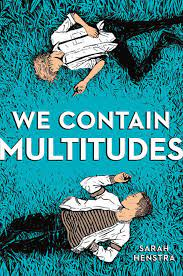
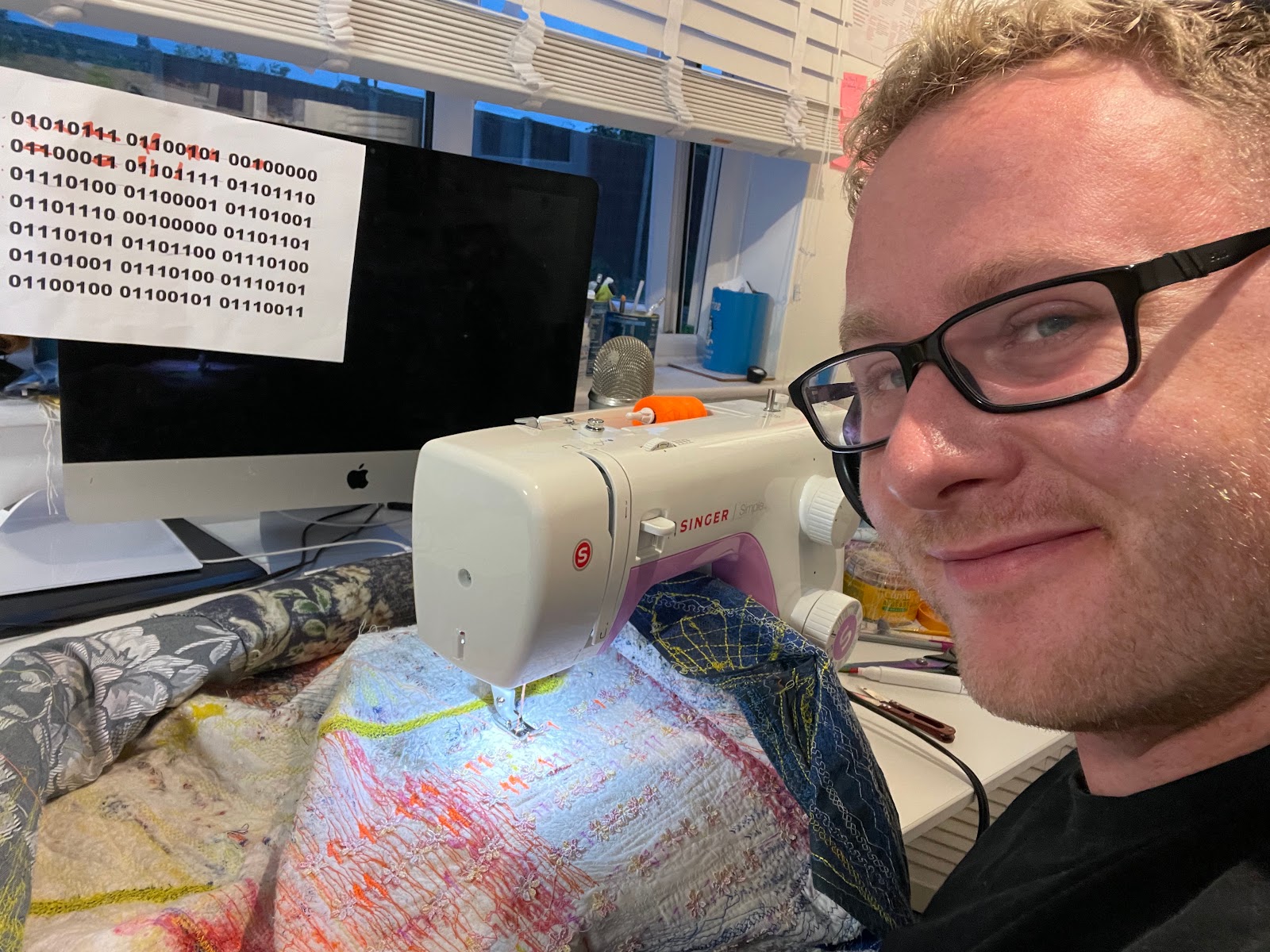


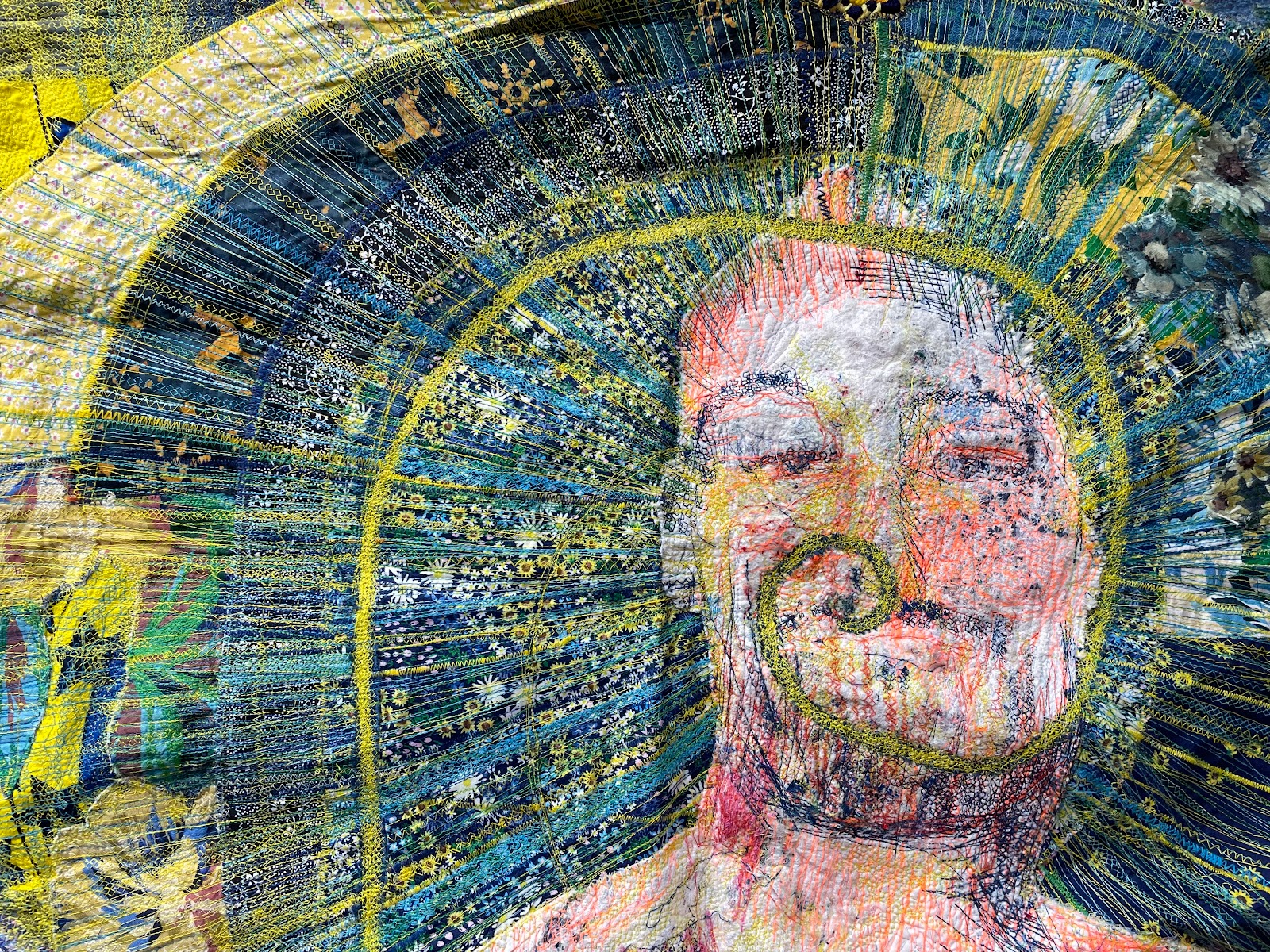








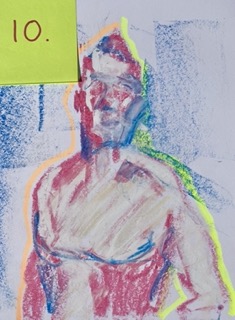

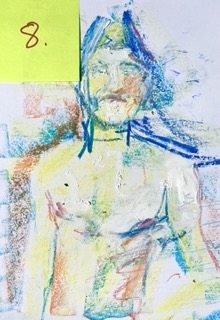


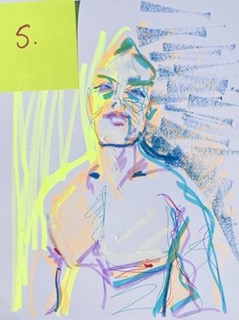







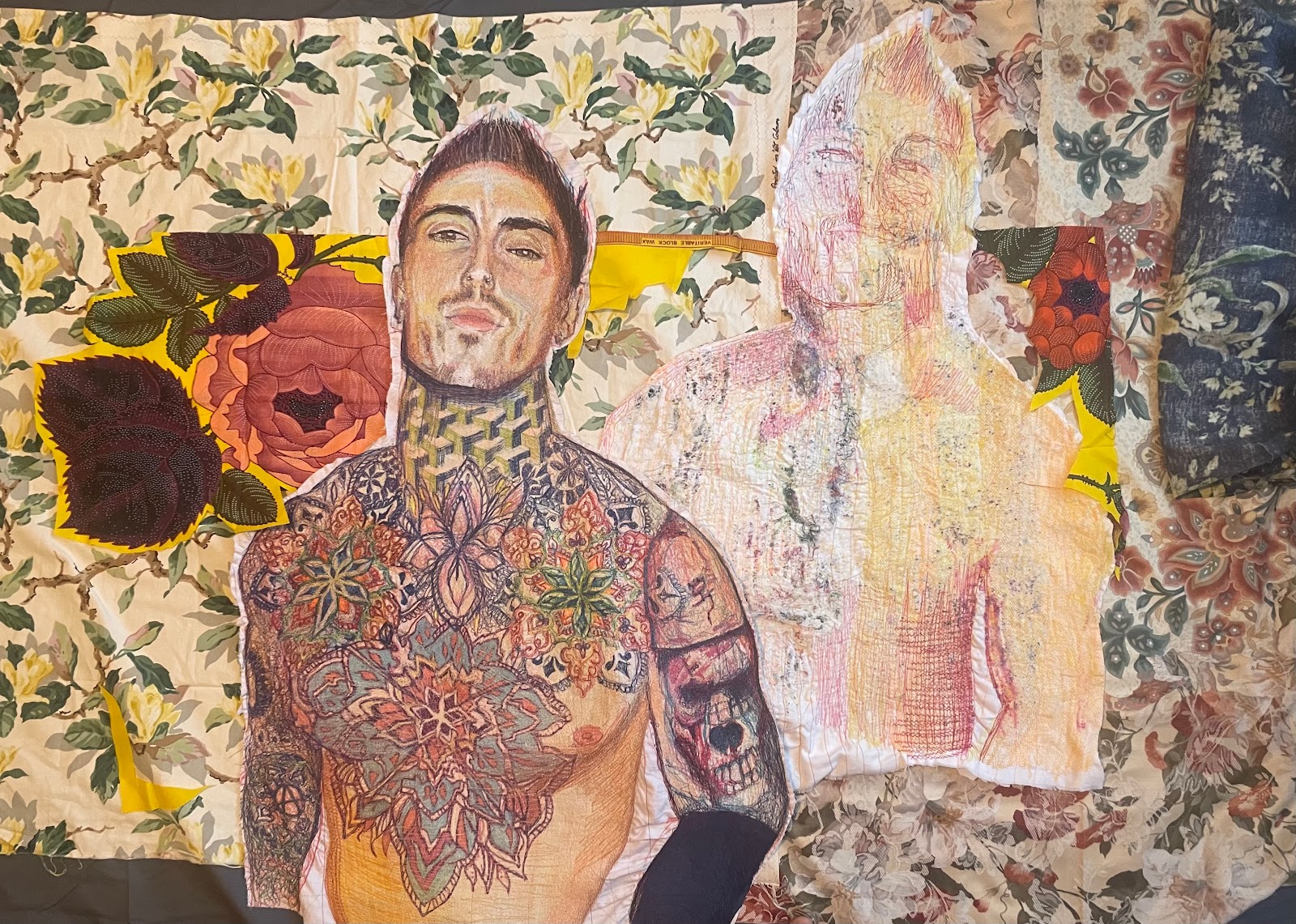
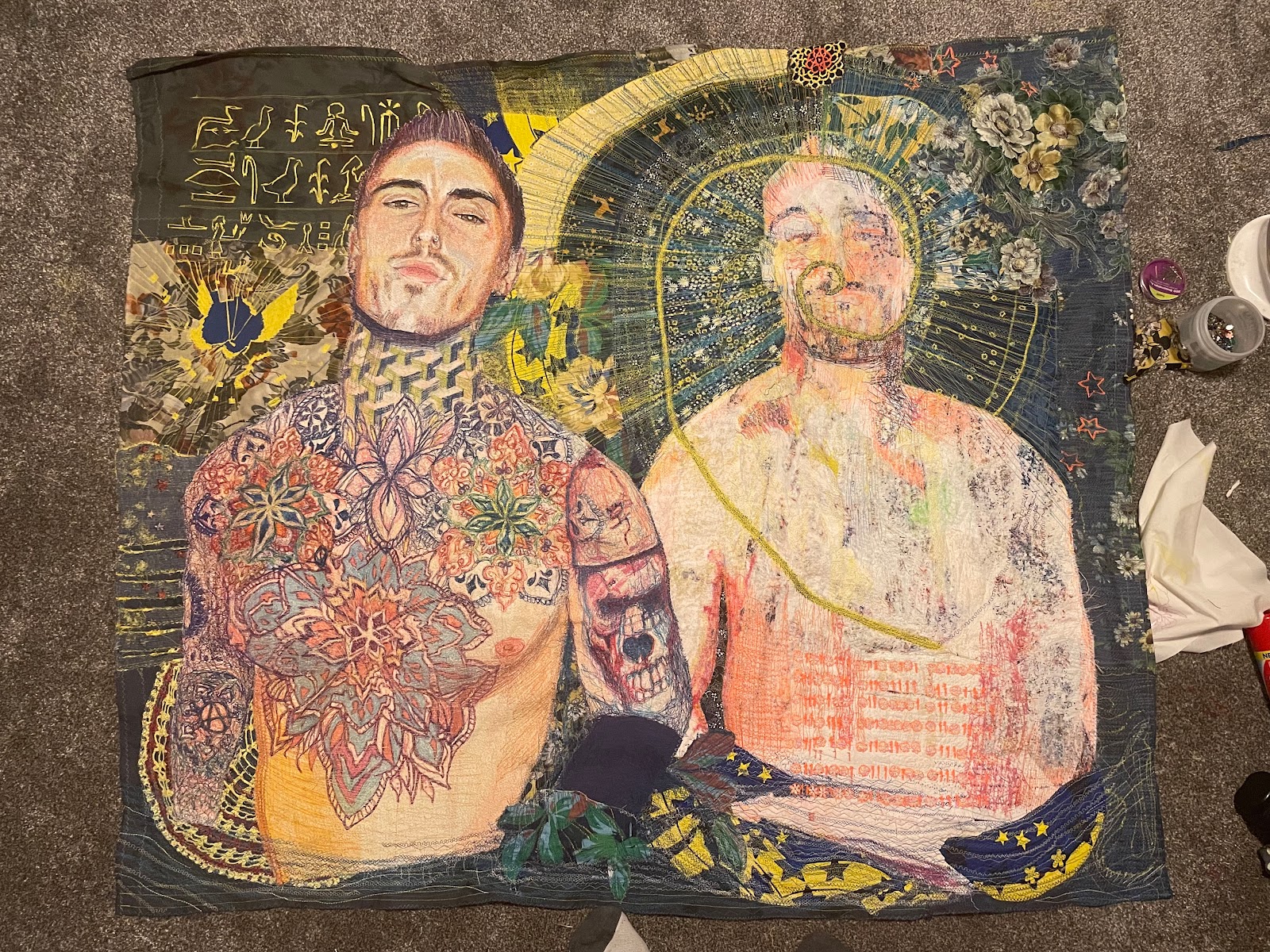



No comments:
Post a Comment